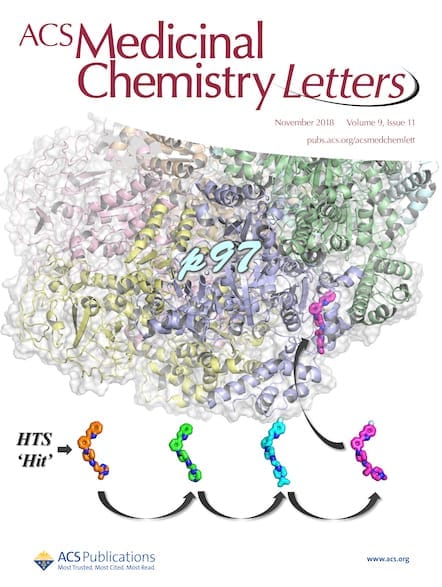In celebration of ACS Medicinal Chemistry Letters’ 10th Volume Anniversary, I asked each member of the journal’s Early Career Board for their most influential article within the medicinal chemistry space and why. Medicinal chemistry early career chemists — consider this your summer reading guide! Ashley Adams, Chair What Makes a Great Medicinal Chemist? A Personal […]

In celebration of ACS Medicinal Chemistry Letters’ 10th Volume Anniversary, I asked each member of the journal’s Early Career Board for their most influential article within the medicinal chemistry space and why. Medicinal chemistry early career chemists — consider this your summer reading guide!
Ashley Adams, Chair
What Makes a Great Medicinal Chemist? A Personal Perspective
J. Med. Chem., 2018, 61, 17, 7419-7424
DOI: 10.1021/acs.jmedchem.7b01445

One article that I have found particularly useful as an starting point for approaching the enterprise of medicinal chemistry is Mark Murcko’s “What Makes a Great Medicinal Chemist? A Personal Perspective” Miniperspective from the Journal of Medicinal Chemistry in 2018. As an early career industrial chemist, I’ve aimed to learn as much as I can as efficiently as possible. Learning the intricacies and science of medicinal chemistry and its interwoven disciplines is a significant task. Identifying and honing skills that can be leveraged in this arena provides yet another learning curve. Several of the highlighted attributes remind me of colleagues that have mentored me along the way, those who know deeply the history of drug discovery and share that knowledge broadly. In my opinion, this article can provide a useful guidepost during the early years in industry and beyond.
Terry W. Moore, Vice Chair
Polar Recognition Group Study of Keap1-Nrf2 Protein-Protein Interaction Inhibitors
ACS Med. Chem. Lett., 2016, 7, 9, 835-840
DOI: 10.1021/acsmedchemlett.5b00407

One of the major projects in my research group is to develop non-covalent activators of a transcription factor called NRF2, one of the major regulators of the cell’s response to oxidative stress and a target of interest at several organizations. To develop these types of activators, a common strategy in the literature has been to block degradation of NRF2 by blocking the protein-protein interaction between NRF2 and its negative regulator, KEAP1. The interaction occurs when negatively charged residues from NRF2 bind in a positively charged pocket on KEAP1, and many of the small molecule NRF2 activators developed thus far have contained carboxylic acids. A paper from a few years ago by Qi-Dong You, Zheng-Yu Jiang, and coworkers was the first, to my knowledge, to examine bioisosteres of the carboxylic acids in a series of NRF2 activators. The paper was scholarly and rigorously executed, and it has been useful in some of the work that is currently going on in my research lab.
Ryan A. Altman
Metabolically Stable tert-Butyl Replacement
ACS Med. Chem. Lett., 2013, 4, 6, 514-516
DOI: 10.1021/ml400045j

Ever since my graduate career, I’ve been intrigued by the perturbations imparted by fluorine on physicochemical properties of a molecule and the downstream implications of basic reactivity and drug-like properties. In this light, I greatly appreciated this article by Barnes-Seeman and Novartis co-workers. In this manuscript, the metabolic stability of a series of t-Bu replacements was evaluated, and a cyclopropyl-CF3 substituent demonstrated improved stability in microsomal samples (rat and human) and in vivo PK (rat) on a simple model system. This improved stability was translated to deliver an analog of finasteride possessing improved stability. This replacement functional group replaced all of the fully sp3 C−Hs from the t-Bu group with either F or with C–H bonds bearing increased s-character, both of which reduce the metabolism of the t-Bu group.
Annalaura Brai, Member
Host-Directed Inhibitors of Myxoviruses: Synthesis and in Vitro Biochemical Evaluation
ACS Med. Chem. Lett., 2011, 2, 11, 798-803
DOI: 10.1021/ml200125r

As a young Ph.D. student, I was really impressed by this publication regarding the identification of a novel class of host targeting antivirals with potent activities against myxoviruses. This publication was of particular interest for me, since ten years ago only a few examples of indirect-acting antivirals were reported in the literature. The advantages of this strategy were very well explained in the paper; authors identified compounds able to interact at the same time with multiple viruses, reducing resistance and without toxicity for primary cells, demonstrating that human protein dispensable for viruses but not for human cells are good targets to develop antivirals. Through their medicinal chemistry efforts, the authors improved the activity of the hit compound and discovered JMN3-003, which showed nanomolar activity against different myxoviruses. In my opinion, this paper opened a new scenario in the antiviral research, highlighting the possibility to create novel not conventional drugs host-directed.
Jennifer E. Golden, Member
Rings in Drugs
J. Med. Chem., 2014, 57, 14, 5845-5859
DOI: 10.1021/jm4017625
The authors assessed the emergence, properties, frequency, and therapeutic relevance of various cyclic frameworks in marketed drugs. This analysis was intended to provide discovery insight, such as how to select chemical libraries for screening and what may successfully propel the conception of new structural, drug-like architecture. The conclusion drawn from the analysis was that marketed drugs are often built from previously vetted and successful substructures. Many years before this article made its debut, I had launched my chemistry career in the pharmaceutical industry, working with others to design drug molecules to successfully navigate the translational drug discovery gauntlet. Retrospectively, the conclusions of the paper were familiar in that there was safety in a recognizable structural motif that had passed preclinical scrutiny. Looking forward, these lessons were valuable when I decided to pursue an academic drug discovery opportunity that matched biologists with diverse interests with medicinal chemists to find and develop novel chemical probes.In 2014, we were completing our program goals, and I was planning my transition to an academic position when this article was published. The paper resonated with me. Many of the guiding principles highlighted therein were routinely employed by my teams during the hit selection process and throughout the innovation that followed, turning meager hits into robust lead molecules. Further, the premise that there are well-recognized, pharmacologically-enriched ring systems that one can renovate with new synthetic methodologies to furnish unique structures with differentiated therapeutic opportunities forms the foundation of projects and chemistry that I continue to pursue in my research group. Today, I engineer methodologies to design and assemble new heterocycles with drug-like characteristics, and my group employs these compounds across a diverse landscape of medicinal chemistry interests. It appears that what is good for the academic may also be good for drug discovery, in that pioneering chemistry to devise new configurations of known ring systems may be a pragmatic approach to drive chemical innovation and drug discovery goals.
Giuseppe La Regina
A Common Pharmacophore for a Diverse Set of Colchicine Site Inhibitors Using a Structure-Based Approach
J. Med. Chem., 2005, 48, 24, 7917
DOI: 10.1021/jm058275i

This is the perfect introduction. When you are applying for a grant or preparing a paper, a poster, an abstract, or an oral presentation, the first step is the introduction. Most of the time, it sounds easy, and other times, it is not that simple. Why? The first challenges are space (e.g., words) and/or time constraints (e.g., minutes) and the will to say everything, such as ‘our research is the best’!
For example, if the target of our research is a new inhibitor of a protein, I need to know how to answer the following questions: 1. How is the protein made? 2. How many isoforms are known? 3. What is the biological function of that protein? 4. What effect is obtained by inhibiting that protein? 5. Have other inhibitors of that protein already been identified? 6. If so, why did I think about a new inhibitor of that protein? In addition, the context becomes even more complex when my protein is one of the most studied to obtain a certain biological effect.
Do you want to hear a real case? I’ll tell you my story. I am a medicinal chemist, working on design, synthesis, and development of new inhibitors of tubulin polymerization as anticancer agents since 2001. In 2005, I used to be a post-doc researcher at the Welsh School of Pharmacy, Cardiff University (UK). My challenge was my 10-minute in a 1-slide oral presentation about new inhibitors of tubulin polymerization at my first group meeting. That has not been an easy task, hasn’t it? Firstly, I searched on SciFinder Scholar “tubulin inhibitors” as a research topic, and the outcome was more than 2400 references….it was a huge number to read them all!
Nevertheless, there was one, published in that year by Gussio and coworkers in Journal of Medicinal Chemistry (doi: 10.1021/jm050502t), which kept a secret. In fact, the authors answered all the above questions in just 123 words! A brilliant example of perfect introduction for any oral communication about anti-tubulin agents. It was clear, short and amazingly comprehensive. Even today, when I am invited to speak about new inhibitors of tubulin polymerization at national and international meetings, I have not yet found more suitable words to introduce my research!! In conclusion, look back at what has been done and build your story on the shoulders of the giants!
Zhengqiu Li
A Small Molecule-kinase Interaction Map for Clinical Kinase Inhibitors
Nat Biotechnol., 2005, Mar;23(3):329-36. Epub 2005 Feb 13.
DOI: 10.1038/nbt1068

I think this paper influenced my current career significantly. I read this paper when I started my research career. From this paper, I got to know that the target identification of bioactive molecules is crucial for drug development, especially about the understanding of drug action and potential toxicities. But the method described in the paper just limited in the in vitro environment, and it was still a great challenge to identify the target under native conditions at that time. This drives us to develop methods that are suitable for in situ conditions. With this idea in mind, over the years, we have been focusing on developing various minimalist linkers that can be applied in chemoproteomics and bioimaging approaches for studying the bioactivity of small molecules with live cells and tumor tissues, which can provide valuable clues for the understanding of drug action.
William C.K. Pomerantz
Bromodomains: Are Readers Right for Epigenetic Therapy?
ACS Med. Chem. Lett., 2012, 3, 9, 691-694
DOI: 10.1021/ml300221t

Over the last seven years, ACS Medicinal Chemistry Letters has been a go-to resource for me for reading up on the latest drug discovery efforts in my field. My group has created new methods to aid chemical probe development for epigenetic proteins, particularly using fragment-based design. In its inaugural year in 2010, this journal was already gathering manuscripts from thought-leaders in the field, including Andrew Hopkins and Phil Hajduk on new approaches for fragment-based drug discovery. Since I started my own lab in 2012, this journal has also helped me keep pace with the explosion of literature on bromodomain chemical probe development including thoughtful commentaries on the clinical potential of bromodomains as drug targets. I recommend, Stuart Conway’s “Bromodomains: Are Readers Right for Epigenetic Therapy?” ACS. Med. Chem. Lett, 2012, 3, 691-4. which helped get me started!
Naomi S. Rajapaksa
The Role of Ligand Efficiency Metrics in Drug Discovery
Nat Rev Drug Discov. 2014 Feb;13(2):105-21.
DOI: 10.1038/nrd4163

Early in my career as a medicinal chemist, I was encouraged to read “The Role of Ligand Efficiency Metrics in Drug Discovery” by Hopkins et al. 1 This work compiles and defines metrics from the literature, such as ligand efficiency (LE) and lipophilic ligand efficiency (LLE), that correct a compound’s in vitro potency for its properties, such as heavy atom count and lipophilicity, respectively. The authors advocate applying these metrics in drug discovery programs to compare compounds and optimize potency while balancing properties. These concepts have had an influence on my approach to data analysis and design in my own projects and have encouraged me to evaluate compounds beyond potency alone. I recommend this paper, along with related articles that analyze the use and validity of ligand efficiency metrics, to any new medicinal chemist.
